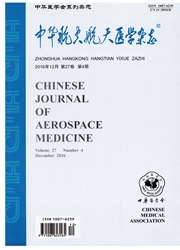

 中文摘要:
中文摘要:
目的探讨血管紧张素Ⅱ1型受体(AT1)阻断对模拟失重大鼠动脉血管收缩以及舒张反应性的影响。方法32只SD大鼠随机等分为对照组(CON),模拟失重组(SUS),对照+氯沙坦(losartan)组(CON+L),模拟失重+氯沙坦组(SUS+L),采用尾部悬吊大鼠模型模拟失重的生理影响,其中CON+L组以及SUS+L按照30mg·kg^-1·day^-1的剂量给予氯沙坦干预。3周后,采用离体动脉血管环技术观察大脑基底动脉和股动脉血管环对氯化钾(KCl)、5-羟色胺(5-HT)、苯肾上腺素(PE)、乙酰胆碱(Ach)、硝普钠(SNP)的反应性,以判断动脉血管的收缩以及舒张反应性的变化。结果SUS组大鼠基底动脉对KCl和5-羟色胺收缩最大反应性增强(KCl:F=14.018,P〈0.01;5-HT:F=27.435,P〈0.01),Ach内皮依赖性舒张最大反应性下降(F=49.045,P〈0.01),股动脉对KCl以及苯肾上腺素收缩反应性与对Ach的舒张反应性均下降(KCl:F=19.244,P〈0.01;PE:F=19.037,P〈0.01;Ach:F=44.973,P〈0.01)。SUS+L组大鼠基底动脉收缩高反应性以及Ach舒张低反应性均得到改善(收缩:F=14.018,P〈0.01;舒张:F=49.045,P〈0.01),而氯沙坦干预对股动脉收缩以及舒张反应性并没有影响。结论局部肾素-血管紧张素系统(L-RAS)参与了模拟失重大鼠动脉血管功能重建过程,前半身与后半身动脉血管组织L-RAS差异性激活可能是模拟失重所导致的动脉血管功能分化性改变的重要因素之一。
 英文摘要:
英文摘要:
Objective Local renin-angiotensin system (L-RAS) has been reported to be activated in simulated microgravlty rat vasculature. However, the functions of which were seldom studied. Present study tended to elucidate the effects of angiotensin Ⅱ type 1 receptor blockade with losartan on arterial vasoreactivity in simulated weightless rat. Methods Tailsuspension rat model was used to simulate the effects of mlcrogravity on vessels. Thirty-two Sprague-Dawley rats were randomly divided into four groups: control (CON), simulated microgravity rat (SUS), losartan- treated control (CON+L) and losartan-treated SUS (SUS+L). Rats assigned to CON and SUS groups received vehicle (distilled water). Distilled water containing losartan at 30mg · kg^-1 · day^-1 was administered to rats in CON+L and SUS+ L groups. Three weeks later, we examined arterial responses to potassium chloride (KCl), 5-hydroxytryptamine (5-HT), phenylephrine (PE) and acetylcholine (Ach), sodium nitroprusside (SNP) in basilar artery and femoral artery. Results After 3-weeks, we found that head-down tail suspension induced enhanced maximal vasoconstrictire response to KCl (F=14. 018,P〈0.01), 5-HT (F=27. 435,P〈0.01) in basilar artery and decreased maximal vasoconstrictive response to KCl (F= 19. 244, P〈0.01), PE (F= 19. 037, P〈0.01) in femoral artery from SUS. Ach induced concentration-dependent vasodilatation in all the artery rings, but with significantly smaller amplitude in basilar artery (F =49. 054, P〈0. 01) and femoral artery (F= 44. 973,P〈0.01) from SUS than those from control. However, arterial response to SNP was similar in all experimental groups. The treatment of losartan (30 mg · kg^-1· day^-1) ameliorated hyperresponsiveness to vasoconstrictors and Ach-dependent vasodilatation impairment in basilar artery from losartan-treated SUS versus SUS (F= 14. 018, 49. 045; P〈0. 01). Conclusions L-RAS participated in arterial function remodeling in simula
 同期刊论文项目
同期刊论文项目
 同项目期刊论文
同项目期刊论文
 Blockade of AT1 receptor partially restores vasoreactivity, NOS expression, and superoxide levels in
Blockade of AT1 receptor partially restores vasoreactivity, NOS expression, and superoxide levels in Increased vascular cell adhesion molecule-1 was associated with impaired endothelium-dependent relax
Increased vascular cell adhesion molecule-1 was associated with impaired endothelium-dependent relax The activity of soluble guanylate cyclase may be altered by hindlimb unweighting in mesenteric arter
The activity of soluble guanylate cyclase may be altered by hindlimb unweighting in mesenteric arter Cardiovascular changes of conscious rats after simulated microgravity with and without daily -G(x) g
Cardiovascular changes of conscious rats after simulated microgravity with and without daily -G(x) g Changes in potassium currents of vascular smooth muscle cells from hindquarter arteries of 4-wk simu
Changes in potassium currents of vascular smooth muscle cells from hindquarter arteries of 4-wk simu 期刊信息
期刊信息
